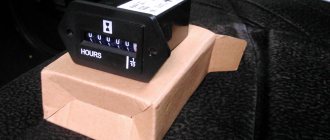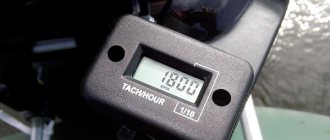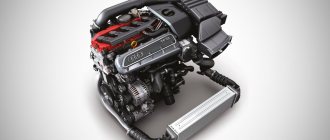The number of engine hours is one of the most important parameters of agricultural machinery, which indicates the working life of the engine, chassis and other important components of the unit. For many beginners, it is quite difficult to calculate this characteristic, much less convert it into kilometers. In fact, there is nothing complicated about this - just follow a number of tips that will help you understand the essence of this important parameter.
Give an answer to the question: “What are the engine hours on a tractor?” It’s quite simple if you understand how this important parameter is fixed. When the engine is started directly, an electronic or mechanical counter begins to work, recording and storing the speed of rotation of the engine shaft. For this purpose, a special indicator is provided in the meter design. This simple device makes it possible to calculate the duration of tractor operation over a certain period of time.
At the same time, the opinion that one engine hour of a tractor is equal to one hour of time will be erroneous. Calculation of engine hours in kilometers is done taking into account revolutions per minute. In this regard, this parameter may differ several times when the tractor is idling and under high loads.
How many engine hours are in one hour?
Counting the engine hours spent by a tractor helps to understand the degree of wear on the most important moving mechanisms of the unit.
The formula used for the calculation is extremely simple and gives the tractor owner the following data:
- when operating an agricultural machine at idle speed, 1 engine hour is equivalent to one full hour of real time;
- with normal load on the tractor, one engine hour is accelerated by about a third, thus amounting to 40 minutes of real time;
- in case of operation of the unit under maximum loads, 1 engine hour is equal to 20 minutes of real time.
Using this information, even a novice farmer can easily convert engine hours to real-time hours. It should be remembered that the final result of converting engine hours into real-time clocks is always slightly different for a gasoline engine and a diesel engine. The main reason for this is the higher power of the latter, which is why it spends a little less time on completing tasks.
Just as in the case of converting a tractor's engine hours into real-time clocks, beginners have difficulty converting engine hours into kilometers traveled by the tractor. In the second case, many more questions may arise, since it is almost impossible to accurately convert engine hours into kilometers - this can only be done relatively and approximately.
First of all, you need to remember that some manufacturers of agricultural machinery set almost identical conditions for calculating engine hours. In most cases, 50 of these units equals 5 kilometers traveled by the tractor under moderate loads. At the same time, if the tractor very often works under intense loads and regularly performs the functions of an assistant, both in the garden and in the local area, then the number of engine hours worked by it confidently increases upward without significant changes in its mileage.
It is important to remember that each tractor uses the motor resources inherent in its engine and other components differently. You can always find more accurate information about the features of calculating this important parameter in the operating instructions for the agricultural machine.
More accurate data on engine hours worked and kilometers traveled can be provided by the memory of the on-board computer, but this kind of device is provided only in the latest models of tractors put on the market, and then only in large-sized units designed to work on large areas.
Another important and no less common question is how to convert engine hours to machine hours. First of all, it should be clarified that this is almost impossible to do, since engine hour and machine hour are completely different concepts in their essence.
Engine hour
– this is a conditional value that is determined taking into account the number of revolutions produced by the crankshaft of the tractor engine over a certain period of real time.
Machine hour
- this is the amount of real time that had to be spent on the manufacture of a specific product. In the case of agricultural machinery, this parameter indicates the time spent performing one or more actions - plowing, harrowing, sowing seeds or planting tuber crops.
The calculation of machine hours is usually carried out by the authorized competent body of the agricultural enterprise. This takes into account the time spent preparing the site, caring for the beds and transporting the crop. The data obtained is summarized, after which management receives data on the time that had to be spent on carrying out basic agricultural work. Keeping such records allows the governing body to develop plans that will further help reduce the time spent on growing their products.
It should be noted that the number of engine hours for gasoline and diesel engines is always slightly different. This is due to the fact that engines running on diesel fuel have more power - this allows you to carry out certain agricultural work faster. This feature is one of the main reasons why most manufacturers of agricultural machinery equip their units with diesel engines.
Often machine hours become an explanation of the difference between a tractor and a bulldozer. The fact is that the operation of a tractor, as a more maneuverable unit, gives the enterprise an important advantage in the form of accelerated completion of agricultural work. When using bulldozers, you have to spend much more time, which is why the latter are used much less frequently in agriculture.
Engine hour
motoch”as, -a, pl. h. -“s, -“ov
Russian spelling dictionary. / The Russian Academy of Sciences. Institute rus. language them. V. V. Vinogradova. - M.: "Azbukovnik". V. V. Lopatin (executive editor), B. Z. Bukchina, N. A. Eskova and others. 1999.
See what “motor hour” is in other dictionaries:
- engine hour
- engine hour... Spelling dictionary-reference book
engine hour
- engine hour ... Dictionary of abbreviations and abbreviations
engine hour
— (2 m); pl. engine hours /, R. engine hours / in ... Spelling dictionary of the Russian language
Engine hour
— a unit of measurement for the duration of operation of combat and auxiliary tracked vehicles. M. calculates the power reserve of combat and auxiliary tracked vehicles; in M. the frequency of maintenance of tracked vehicles is determined and ... ... A brief dictionary of operational-tactical and general military terms
engine hour
- motor hour motor hour ... Dictionary of Russian abbreviations
engine hour
- moto/hour/... Morpheme-spelling dictionary
motosagat
— (Motor hour) ұрыстћ зқәе комекші шынжыр тундди мінкалARDын зъріс қоріс қорін esepteuge arnalgan, zhumys іsteu uzaktyғynyn аlshe bіrlіgі. m.
GOST 4.120-87: System of product quality indicators. Motor graders. Nomenclature of indicators
— Terminology GOST 4.120 87: System of product quality indicators. Motor graders. Nomenclature of indicators original document: 1.3. Height of grader blade with blades (GOST 27008 86), mm Definitions of the term from various documents: Height... ...
GOST 4.474-87: System of product quality indicators. Construction tower cranes. Nomenclature of indicators
— Terminology GOST 4.474 87: System of product quality indicators. Construction tower cranes. Nomenclature of indicators original document: 1.1.3. Reach (ST SEV 723 77), m: l3 Definitions of the term from various documents: Reach 1.1.4. Height... ... Dictionary-reference book of terms of normative and technical documentation
gamma percentage resource
— 3.32 gamma percentile life: The total operating time during which the object will not reach the limit state with probability y, expressed as a percentage. [GOST 27.002 89, article 6.15]
Everyone knows how to approximately determine the service life of a passenger car engine - by mileage. Of course, it is important to take into account other factors, such as operating conditions (climate, road quality, load), but in general the condition of the engine is judged by the distance traveled by the car and is rarely mistaken. The more the car has driven, the more the engine has been “overclocked”, the more its components and parts are worn out, and the sooner they will require replacement or preventive maintenance. But how to calculate the engine hours and work volume of tractors, agricultural trucks, and snowplows? Most often, during operation, they travel a very short distance, but they experience a noticeable load. In order to correctly determine the degree of wear, you need to know what engine hours are on a tractor and other equipment and how to count them.
The engine hour is a special unit of measurement of the load experienced by a running motor.
It corresponds to one astronomical hour of crankshaft operation at idle or moderate speed (60 minutes at about 1500-1600 rpm). This indicator is not equal to mileage or operating time and is relevant primarily for small-capacity vehicles (motorcycles, including cross-country motorcycles), as well as special equipment, the operation of which is not assessed by the distance traveled.
- The most accurate is based on crankshaft revolutions. 1 engine hour is 96,000 crankshaft revolutions (for convenience, you can round up to 100 thousand).
- In terms of time, this is approximately one hour of idling engine operation.
- Based on the fuel used.
The engine hours show the load of the working tractor
Equipment, the amount of work of which is not calculated based on kilometers traveled, is equipped with a special meter that is connected to the spark plugs and reacts to sparks. This is the easiest and most reliable way to count engine hours on tractors, walk-behind tractors and other equipment.
How are engine hours calculated?
The engine hour is a special unit of measurement of the load experienced by a running motor. It corresponds to one astronomical hour of crankshaft operation at idle or moderate speed (60 minutes at about 1500-1600 rpm). This indicator is not equal to mileage or operating time and is relevant primarily for small-capacity vehicles (motorcycles, including cross-country motorcycles), as well as special equipment, the operation of which is not assessed by the distance traveled.
There are different ways to calculate engine hours:
- The most accurate is based on crankshaft revolutions. 1 engine hour is 96,000 crankshaft revolutions (for convenience, you can round up to 100 thousand).
- In terms of time, this is approximately one hour of idling engine operation.
- Based on the fuel used.
Equipment, the amount of work of which is not calculated based on kilometers traveled, is equipped with a special meter that is connected to the spark plugs and reacts to sparks. This is the easiest and most reliable way to count engine hours on tractors, walk-behind tractors and other equipment.
How many engine hours in one hour
It is believed that 1 engine hour can be equated to 1 hour of engine operation at idle speed, but this is a very approximate method. Idle speed varies between vehicles. Only in passenger cars the spread ranges from 500 to 900 rpm, and, for example, in the MTZ-80 tractor they can reach 1500 rpm. The crankshaft revolutions are displayed on the tachometer. The higher the speed, the faster the engine hour is consumed. Therefore, it is impossible to derive a single coefficient to find out how long the engine hour is. It all depends on the working conditions. For example, if a tractor or walk-behind tractor is running on light sandy soil with a cutter or potato planter, the operator will not need to maintain high speeds. And if the same tractor is pulling a truck out of a snowdrift or clearing wet snow, the load on the engine will be higher and the crankshaft will make more revolutions.
Design and principle of operation of instruments for measuring engine hours
Understanding the importance and necessity of monitoring and accounting for the resource consumption of the unit, engineers developed and put into operation automatic devices - engine hour meters.
Features of hour meters and methods of their use
Different types of meters have been developed for different vehicles.
Hour meter for tractor
The calculation algorithm assumes that at idle, 1 engine hour of the tractor is equal to 1 hour of real time.
At standard load, the engine hour increases by almost a third. Under normal loads, 1 engine hour lasts approximately 40 minutes. Under intense load, the engine wears out two-thirds faster.
Hour meter for tractor PHOTO: drive2.ru
Hour meter for car
Different components of a car wear out differently during the same operating time. It is also important to consider whether the car was in motion or stood still with the engine running. These considerations apply to any vehicle. Typically, 200-250 engine hours for a car is 15,000 - 17,000 km. It all depends on how long the car has been parked with the engine running.
The presence of an hour meter in the car allows the owner to more competently plan maintenance and replacement of components and assemblies.
Different types of sensors have been developed for cars, depending on what unit they are supposed to monitor. All types are based on a time counter, but the difference between them lies in the method of activating the start of the countdown. They can start when the ignition is turned on, when the engine vibrates, or in other ways. The clock mechanism itself can be electromechanical or electronic.
Hour meters vary in price - from quite cheap (no more than 500 rubles), to expensive ones, designed for boats and yachts, in a sealed design, costing up to 8,000 rubles. There are also meters with mechanical drums, like in the odometers of old cars, only they count not kilometers, but engine hours.
Built-in universal tachometer RL-HM005L with hour meter and backlight (backlight only works from an external power supply of 6-48 V). Designed to measure engine speed and operating time. Can be used on motorcycles, snowmobiles, ATVs and outboard motors:
- two-stroke: 1, 2, 3 cylinders;
- four-stroke: 1, 2, 4, 6 cylinders.
For use with gasoline internal combustion engines only. Connects to the engine spark plug, the signal wire is wound around the spark plug
Hour meter for a car PHOTO: alligator-boat.ru
Hour meter for outboard motor
The peculiarity of this counter is that after the first turn on, the tachometer remains on all the time and displays the number of engine hours worked on the screen. You can forcefully turn off the tachometer by pressing and holding two special buttons, but then the engine hour meter will be reset. Switching between modes (tachometer or counter) occurs automatically: when the engine is running, the tachometer is displayed, after the engine is stopped, the hour meter is displayed.
Hour meter for outboard motor PHOTO: mysku.ru
Hour meter for diesel engine
One of the meter options for diesel is model TS-013. This is a non-contact digital tachometer with built-in hour meter function for diesel engines and electric vehicles.
Electronic hour meter for diesel engines PHOTO: mytahometr.ru
Engine hour meter for generator
Maintenance of units, including gas generators, is tied to engine hours or time intervals. The concept of engine hours is discussed above. In the case of a generator, a specific issue is signal pickup and protection from interference. There are capacitive sensors, their connection is non-contact. It is produced by wrapping several turns of the wire coming from the sensor, the high-voltage conductor of the spark plug. The second issue is solved by protecting the device with a tin screen.
Engine hour sensor for a gas generator PHOTO: radiobezdna.ru
Hour meter for walk-behind tractor
Portable non-contact digital inductive tachometer TS-011. Built-in functions of an hour meter and countdown until the next maintenance.
Hour meter for walk-behind tractor PHOTO: promotoblok.ru
Other varieties
Counters activated by pulses from the ignition system.
A counter activated by pulses from the ignition system PHOTO: drive2.ru
Counters activated by engine vibration.
Counter activated by engine vibration PHOTO: drive2.ru
Electromechanical meter with activation when power is applied.
Meter with activation when power is applied PHOTO: drive2.ru
Conversion to kilometers
It is also not possible to derive an exact formula for what 1 engine hour is equal to in km. For passenger cars, it can be approximately equated to 12-14 kilometers of quiet driving at moderate speeds or idling the engine. Thus, 15 thousand km is the standard interval for changing oil and some other consumables - this is about 200–250 hours of engine operation.
When driving aggressively, driving on bad roads, transporting cargo or towing, which often requires using full engine power, the engine hours will be “used up” faster. And if the car is driven on busy streets or often idles warm up, these units of measurement become more than mileage. After all, the car is stationary, and the resource of the engine and some other units is consumed. That is why, when replacing consumables, it is better to focus on motorcycle hours rather than mileage.
Engine hour consumption is recorded by a special device.
The issue of accurate calculation is especially important for vehicle drivers working far from qualified assistance (in forest areas, facilities under construction, extreme recreation). They need to know the production so that they can replace or inspect parts in time to avoid unexpected breakdowns. If you can’t rely on mileage, it’s worth purchasing a meter.
How to wind an electronic watch
A friend turned to me, like: “...put on ten hours... if possible, well, you’re a radio engineer, figure it out...” I figured it out on the second day. There is almost no information on the internet, or come on over - we’ll do it! And don't worry, I'll do it myself! And did! Given: KD8083 on MTZ-83 We have: -25 hours As a result: we beat off the minus and went into plus for two days! Total: the processor (internal) was not reprogrammed, everything is in normal mode, astronomical hour = 1 hour. I did it on the NE555 (VI1) generator, only calculated and selected my own frequency data.
As you can see in the photo, at 800 Hz = 3500 rpm.
In the old diagram (Fig. 1), the calculation is not correct (DO NOT repeat the diagram), but the dependence of frequency on revolutions has been measured in practice. Below is a diagram of the NE555, “in theory and on a prototype model”
The dependence of frequency on the clock is independent. The main thing: the signal frequency is at least 200 Hz! and At least 2 V!
PS I went to bed, photos tomorrow...
Scan with the old circuit, it doesn’t work, do it on VI1 or NE555, select a frequency of no more than 700 Hz!
Difference between engine hour and machine hour
Machine hours refers to the time it takes one machine to complete a job and also takes into account the number of machines. For example, if one machine clears the street of snow for six hours, it is said that six machine hours were generated. If two machines were assigned to the same amount of work and they cleaned the street in three hours, the work time is multiplied by the number of machines, and the result is again six machine hours. This indicator is important for distributing the load on the vehicle fleet and planning trips. Thus, the exhausted life of the engine is measured in engine hours, and the amount of work of the equipment as a whole is measured in machine hours.
Tractor MTZ-80
Reviews
They show me that the engine hour is 40 hours in real time, is this true or not?
According to all manuals, 1 engine hour = 1 hour of actual time when operating at rated speed. The rated speed is the indicator at which the engine develops maximum power. MTZ 80 has 2200 rpm. Others may vary.
Its mileage information can be used to assess transmission wear on any vehicle. But when determining the service life of engines, hours are taken into account first. This important parameter significantly affects the indicators and recommendations related to the operation of a particular car model or device. In addition, the parameters are measured in a similar way for units installed in vehicles or for those that operate stationary. This information is extremely important for monitoring the performance of the engine, as well as for determining the exact time for its maintenance, as well as for repairing and replacing consumables.
Marketing component
For new cars, the oil change is dictated to us by the manufacturer, and this process miraculously coincides with the next maintenance. That is, we are somehow getting used to giving a lot of money when we come to the dealer in 15,000, they will tweak something for us and look at something, so here you are 6,000 - 10,000 rubles! EXPENSIVE, yes of course EXPENSIVE! Therefore, now drivers look at the service interval and the longer it is, it is considered better. I’ve already said about Europe - that it’s not uncommon for there to be 20-25,000 kilometers, because their prices for work are even higher.
BUT IS THIS CORRECT? Of course not. Moreover, now many car owners live in big cities with a lot of traffic jams and threshing engines in them; it is also worth adding auto starts in the morning or set on a timer (turned on by time or by ambient temperature).
And here you need to understand that the replacement should take place not according to mileage, but according to engine hours! And believe me, this greatly reduces the replacement interval in kilometers, by about half (but more on that a little later).
What are engine hours?
This is a certain period of time, in this case one hour, during which your power unit (motor) worked - hence “MOTO” - “HOUR”. Everything seems to be very simple, you can easily calculate the crankshaft revolutions during this time.
So, for example, at idle speed we have 900 - 1000 per minute, multiply by 60 we get - 54,000 - 60,000 per hour, the crankshaft rotates.
AT higher speeds, say track and 4000 rpm, 60 X 4000 - 240,000 and so on.
Nobody calculates exact information on how many revolutions the shaft has made, this is not particularly necessary, there is simply an average component, it is called MOTOR HOURS, this includes city trips with traffic jams and long periods of standing, as well as highway accelerations.
It is clear that the shaft rotates and there is wear and tear on the walls, liners, bearings, etc. BUT if a good lubricant is poured in, say advanced synthetics, it can level out this wear for some time, making it minimal.
Kilometers or engine hours? — DRIVE2
Engine hours are more indicative than mileage When buying a used car, everyone first looks at the odometer, believing that the condition of the vehicle directly depends on its mileage.
However, mileage does not always indicate how much the vehicle’s resource is actually used up. More precisely, other data allows us to judge the degree of its wear: how many years, months, days, hours and minutes it actually worked.
And this depends on many factors, primarily on operating conditions.
A FEW years ago, the service mileage for most models according to regulations did not exceed 5,000 km. As technology improves and the service life of lubricants increases, the interval between scheduled maintenance has lengthened first to 10,000, then to 15,000, and for some brands even to 20,000 km.
But then the process of increasing mileage between mandatory service visits stopped and even in some cases went in the opposite direction. Dealers began to insist on more frequent car maintenance, citing “particularly difficult operating conditions.”
Many clients did not believe them: - Excuse me, what difficult conditions are you talking about? The car does not drive through the Siberian taiga or through the deserts of Central Asia.
She practically never leaves the asphalt and never leaves the big city! What's so hard about this? At the service center, they deceive us, forcing us to undergo maintenance more often than originally prescribed by the manufacturer! In fact, the service technicians are not lying at all.
The operating conditions of cars in a modern metropolis are indeed, if not approaching extremes, then at least noticeably different from the calculated ones. This was clearly illustrated by our experiment. We cost more than we drive. The editorial “Ford Focus” of 2003 became the test subject. The odometer shows almost 50,000 km.
Over the course of a month, we recorded in detail the daily mileage of the car and, more importantly, the travel time with an accuracy of one minute. As soon as the engine started, the stopwatch immediately started. The data obtained was compiled into a table, from which you can find out that, for example, on Thursday, March 29, the car traveled 60.6 km, while it was on the road for 161 minutes.
Thus, we received detailed information for each day of the experiment. As a result, it turned out that the average daily mileage of the Ford was about 60 km. Knowing the travel time, you can calculate the average speed at which our Ford moved when traveling around Moscow (we never left the city). Only 22.4 km/h. Not much at all, and all because most of the time he was not driving, but standing (of course, with the engine running) in traffic jams, at traffic lights, etc. At best, the car slowly trudged along in first gear in start-stop mode, so that the speedometer needle barely moved near the zero mark.
If your car has a trip computer, then you can easily check this data even without the help of a stopwatch.
When traveling during rush hour in Moscow, for example, your average speed is unlikely to exceed much more than 20 km/h.
Even if on certain sections of the route the flow speed is higher than the 60 km/h allowed in the city, still, when calculating the average value, frequent and long stops will negate this gain.
Mileage does not indicate wear. We carried out the exact same measurements on the second Ford Focus, which, unlike the first, was operated almost in hothouse conditions. During the experiment, he traveled exclusively on weekends, when the roads were relatively free, and mainly outside the city.
So, its average speed, calculated based on the results of the month, was 44.7 km/h - almost twice as much as that of the first Focus. Thus, it turns out that the conditional service interval - say 15,000 km - will be covered by the first car in 670 h, and the second - twice as fast, in about 335 h.
Feel the difference! When the time comes for the second car to go for service again, the first one will only have another 7,500 km on its odometer. Does this mean that the main components and assemblies of a “city dweller”, according to low mileage, will wear out half as much in a month as those of a “country dweller”? No, of course not! Rather, it’s the other way around.
Moving slowly in the “start-stop” mode, the car exhausts its life faster than when driving moderately fast, but evenly. With an irregular driving rhythm, with frequent stops and starts, the driver of a car in a metropolis clogged with traffic has to constantly change gears and squeeze clutch.
He needs to stop more often, which means he needs to use the brakes.
The cooling system, deprived of intensive blowing of the radiator with a counter flow of air, works at the limit of its capabilities... This list of components and assemblies subject to increased wear can be continued further, but the main thing is that the engine of the first car with the same mileage will work twice as long as that of second.
This means that the oil in the engine, through the gaps of the piston group, will be in contact with fuel combustion products longer, oxidize more intensely and lose its properties faster. In other words, it will become unusable and will need to be replaced. The same applies to other consumables, including brake pads.
Let's move on to engine hours? THIS state of affairs was not typical for passenger cars before. A different matter is some kind of agricultural or military equipment, which during operation does not move very much and not too fast.
Nobody ever took into account the mileage of grain harvesters and army tanks; to determine the resource they developed, they used the so-called engine hours, that is, the total time the engine worked. And the timing of scheduled maintenance is determined not by the kilometers traveled, but by the number of engine hours.
As can be seen from our experiment, given the current congestion of city streets, such a practice can be useful not only for specialized equipment, but also for ordinary passenger cars. Perhaps over time, automakers will take this into account. Well, without waiting until hour meters are standardly installed on cars, perhaps on our own initiative we will shorten the service interval of our Ford. For starters, at least 5000 km, and then we’ll see... Some cars, including Toyotas, have an hour meter. A trivial thing in general, but for some reason rare. Let's simulate ideal conditions: - If we consider operation on the highway, then the average speed without traffic jams should usually be no lower than 70 km/h, but in practice somewhere around 80 km/h, then 15,000 km: 70 km/h = 214 engine hours. — If we consider operation in the city, then the average speed without traffic jams should usually be somewhere around 30 km/h, i.e. we get 15000: 30 = 500 engine hours.
Plus, it takes another 50 hours to warm up in winter.
Total, in conditions without traffic jams, 15,000 km is: - in the city is equivalent to ~550 engine hours;
— on the highway equivalent to ~264 engine hours.
Club TOYOTA RAV 4 forum
Oil and its resource
And now the most interesting thing is that no one will tell YOU at the dealer that certain lubricants need to be changed after a certain number of hours, even if your mileage is small, even very small.
WHY? Yes, because the protective properties are lost, that is, the engine will wear out quite a lot
Now there are only three types:
- This is a mineral water. By the way, it has almost disappeared in our country now; it should be replaced after a maximum of 150 engine hours (MH). After such a mileage, it also begins to burn, clogging your power unit.
- Semi-synthetic. It is worth changing it after 250 MH
- Synthetics. This is where the biggest difference is, there are cheap options (API SJ/SL, Mb 229.3, Vw 502, Bmw LL98) - replacing 250MCH. There are more advanced (improved crack) compounds (API SM/SN, Mb 229.5, Vw 502.00/505.00, Bmw LL-01) - here is a replacement for 300MCH. The best purified compounds (PAO approvals, Mb 229.5 Vw 502/505/503.01 Bmw LL-01) – 350 MCH. Thus, in this class of lubricants the run time is from 250 to 350 operating hours. There are others, but they are very expensive - ESTER, the price tag is 3 - 4 times higher than ordinary synthetics, it is simply not profitable to pour it.
Checking the generator at the KI-8927-GOSNITI stand
Turn off the ground switch. Connect the stand device (see Fig. 3). Turn on the "mass" switch, start the diesel engine, set the maximum crankshaft speed and turn off the "mass" switch. After starting the diesel engine with the stand, raise the rheostat electrodes.
Rice. 3. Scheme for checking the voltage regulator and generator on the KI-8927 stand: 1 – generator; 2 – relay regulator; 3 – stand voltmeter; 4 – stand rheostat; 5 – battery; 6 – stand ammeter
Turn the stand into electrical equipment testing mode and set the generator to a load; in this case, the load current of the generator must be 32 A. The permissible voltage value must be no less than 13.2 V in the “Summer” position of the seasonal voltage regulation switch (SVR) and no less than 14.0 V in the “Winter” position.
If, with a working relay-regulator, the load voltage is less than the permissible value, as well as if there is increased noise or knocking, the generator should be removed and sent to a workshop.
How to calculate engine hours?
By the way, on many expensive German foreign cars (for example Mercedes, BMW and others), there is a special counter that counts them. And then it just shows you that you need to go for an oil change, after which it resets to zero and you drive until the next maintenance. That is, there seems to be no exact interval here, AS I THINK THIS IS VERY CORRECT.
German cars often have turbines, the oil wears out even faster because it passes through some components of the turbocharger, removing heat from it and lubricating it, which is why the MOTOR HOURS will be reduced here! Even “top” synthetics are often recommended to be changed every 300 hours.
Method one
However, other modern cars do not have such counters! But there is a calculation of average speed. And here, using logic, you can display the interval.
It is very easy and simple to do, you can even create a small formula.
P=S*M (where P is mileage, S is the average speed of the car from the on-board computer, M is engine hours).
Ideally, after changing the oil, we need to reset the average speed counter and drive at least 2000 km; at low mileage this simply will not be relevant. Then you will have enough data to calculate everything.
ON my car it’s 29.5 km/h, I use a synthetic compound designed for 350 MPH. Thus, 350 * 29.5 = 10325 km. Here is the real replacement period, BUT NOT 15,000 km.
Of course, if your main job is outside the city and you travel intercity, then your average speed will be higher. For example, my friend has it at 50 km/h and also uses synthetics. So much for 300*50km/h = 15000km.
However, residents of large cities such as Moscow or St. Petersburg, where you can be stuck in traffic jams for several hours, this figure can be only 18 - 20 km/h, then 300 * 18 = 5400 km.
Method two
Another replacement option is based on fuel consumption. Ideally, in a combined cycle, my car will consume 8 liters per 100 km. If I calculate how much it will spend on 15,000 - 1,200 liters, that's when I should change the oil! 1200 – remember this number.
However, with winter warm-ups, the consumption in traffic jams is much higher, I have 10.6 liters. As a result, for 15,000, the consumption is 1590l, which is 390l more!!! If you derive the formula and calculate how much mileage is needed to reach 1200l, then it turns out to be approximately 11320km.
We are all accustomed to standard forms of measurement, be it kilometers per hour or amperes per hour. But pilots of small-capacity vehicles care about completely different indicators - engine hours. I think not everyone knows what it is.
- Oh, come on, how many hours has the motorcycle worked for you, and so many engine hours! - someone will say.
I admit, there was such an opinion in my mind too, that how many minutes the engine rumbled, divided by 60 and got the number of hours - voila. But no. It is clear that the newer the model of equipment, the greater the likelihood of an installed sensor that ticks and counts engine hours. However, this in no way prevents fans from looking for comparisons and equivalents, saying that engine hours are how many kilometers or how many liters of gasoline burned, how many times do you need to rush to the nearest village for salt in order for engine hours to run out?
Let's start with something simple: it is useless to determine engine hours in kilometers, because measurement in the usual units of kilometers or miles is a banal mileage. Hence the first discovery, mileage and engine hours are completely different indicators. I will say more, not only motorcycle engines, but also many other small-capacity units for household purposes are tied to engine hours. But what about the equipment that moves little, which wears out its resource, but adds mileage by the nose? How are you going to measure the service life of, for example, a welder or a compressor in kilometers? Is it that how many hours we drive them around the garage will elapse? Moreover, measuring the engine life by the distance traveled is a completely one-sided approach, even if I drive all the time in search of happiness, who said that the engine always runs at the same speed?
Engine hours are tied to the relationship between time and power. The engine hour passes per hour of engine operation at its maximum capabilities, since wear in this case will be the most noticeable. And if you don’t force the engine, moderate speeds are enough for you, then the engine hour will pass in a longer period of time.
Once again, the engine hour is the wear rate per hour of operation at the upper limit of the output power, if you want - the number of engine revolutions and rotation frequency; the higher they are, the sooner the engine hour comes to an end. During quiet operation, the resource is also spent, but not so quickly, so it can take longer to reach the desired ratio of one engine hour at lower speeds than at higher speeds. Hence the frequent hassle with consumables on cross-country motorcycles.
In theory, the amount of fuel consumed can be calculated very, very relatively. Because the more aggressive the driving, the higher the gasoline consumption, and this can be remotely related to engine hours by a couple of dozen light years.
What is this for?
Everything is banal. The resource is being used up, which means you need to mentally prepare for replacing consumables. The more hours are measured, the closer day X is, when you will have to do the inevitable maintenance, change oils and much more. This is a very logical approach, because it is the nature of the operation of our motorcycle that will show how soon we will have to run to the store and fork out for new oils and consumables. After all necessary work has been completed, the clock is updated and can be counted again.
For each engine, these indicators are individual; manuals for using the equipment must indicate after what number of engine hours replacements must be made.
What are engine hours on a tractor and other equipment: monitoring service life
What are engine hours on a tractor and other equipment?
Linguists have not come to a consensus on the question of how to correctly write the word “motor hours” - with a hyphen in the middle between the two roots or together. The “Dictionary of Russian Language Abbreviations”, as well as the “Spelling Dictionary” indicate that the word “motor hour” is written together. But writing with a hyphen is not considered an error.
Any mechanism has contacting parts that rub against each other during operation and gradually wear out. The more intense the operating mode, the more significant the wear of the working surfaces. When operating equipment, maintenance personnel are interested in such an important indicator as the remaining service life. The unit of measurement is considered to be “motor hour”. This value characterizes the duration of operation of the mechanism under load.
This is not just the operating time of the mechanism, it is an accounting of the operating time under certain conditions. Astronomical time is adjusted by the value of specific coefficients, which are the result of certain regime measurements. There are devices that remove almost all the necessary information from the mechanism, calculate it and provide the results to the mechanic in real time.
An engine hour is a unit of measurement for the duration of engine operation, taking into account the quantitative characteristics of all factors. For an internal combustion engine, the main measured quantity is the crankshaft revolutions - their number or rotation speed. The engine hour is either less or more than the astronomical hour.
There is no exact definition of the concept of “motor hour”. In practice, it is sometimes replaced by the usual concept of time, which is necessary in economic calculations, for example, to establish maintenance schedules.
How to calculate engine hours
In the practical work of auto mechanics, it is often necessary to count engine hours to draw up operation and maintenance schedules. The problem is not simple. There is no single, universally accepted counting algorithm. Different methods give different results. But as an initial assessment, they are still useful.
It is known that with an increase in the speed of rotation of the crankshaft, friction in contacting pairs increases and metal wear increases. With variable speeds, obtaining an objective result becomes much more difficult.
Calculations can be completely manual, made using records of readings taken from instruments. And automatic, performed by specialized devices. These devices are used in different types - mechanical, electromechanical, electronic, programmable. The calculation is based on engine speed measured by an automatic tachometer. The formula takes into account total and hourly fuel consumption, actual speed and other operating parameters.
1 hour of operation is taken to be 1 hour of operation of a machine developing rated power. The engine hour is equal to the astronomical operating hour under nominal conditions. At idle, the engine hour value is higher, and at increased load it is lower. These indicators are used to determine the timing of replacement of consumables and maintenance.
Monitoring engine hours in a car PHOTO: drivertip.ru
How to convert engine hours to hours
To convert engine hours into generally accepted time units, the nominal mode is usually taken as the reference point. With an increase in power and, accordingly, crankshaft speed, the number of engine hours in one astronomical hour increases by a third (moderate mode) and by two thirds (intensive mode). This method provides a rough but practically useful estimate of the mechanism's load and wear.
Multifunctional resource monitoring sensor PHOTO: drivertip.ru
Engine hour: how many kilometers is it?
It is more correct to calculate engine life in engine hours than in kilometers. But practitioners more often use distance units for everyone. All maintenance schedules are tied to them. In practice, a special average table is used, which assumes that 1 engine hour for wheeled tractors is 10 km, for tracked tractors – 5 km. At the same time, more accurate calculations require taking into account and evaluating other indicators of operating conditions.
How to convert engine hours to kilometers
Since techies do not have a strict, unambiguous formulation of the concept of “motor hour,” these ideological differences are regulated by binding documents. According to the Order of the State Customs Committee of the Russian Federation dated October 2, 1996. No. 609 “On the introduction of annual standards for the consumption of motor resources (mileage) of vehicles”, introduces the concept of an average indicator for one hour of operation of a machine driven by a motor not equipped with an hour meter. It will be equal to the following mileage: for cars - 25 km; for wheeled tractors – 10 km; for tracked tractors – 5 km. If driving occurs in difficult conditions (driving at high speeds, in traffic jams, etc.), the number of engine hours increases, but the mileage does not keep up with their countdown. Maintenance recommendations given in kilometers (for example, 15-20,000 km) should be reduced. These wishes of the automaker are more consistent with ideal operating conditions.
Practical ways to calculate engine hours PHOTO: youtube.com
Engine hour and machine hour: what is the difference
Engine hours determine the operating time of the engine during which the crankshaft has completed a certain number of revolutions depending on the degree of load. This is a technical specification for operation. A machine hour is a unit of equipment working time used in calculating the costs of producing a certain product. This is already a commercial characteristic. The concept of machine hour is used when organizing road transportation (to calculate salaries for employees) or in agriculture (when calculations indicate the time spent on work performed on tillage, sowing, etc.). Analysis of the situation allows us to draw conclusions about the payback period of investments, the efficiency and feasibility of using this or that equipment, the profitability of production, etc.
How to calculate engine hours?
Methods for calculating engine hours for a diesel engine can be different - from simple mental calculation, with further recording of engine performance indicators, to the installation of special mechanical or electrical meters.
Naturally, the second option is more acceptable - this method of calculation is much more accurate and convenient. Using the counter indicators, you can more accurately monitor the degree of wear of the main operating components of a diesel engine. Data on this technical characteristic are specified in detail in the operating instructions.
Why do you need to count engine hours?
Having figured out how to calculate the engine hours on a tractor, you can now move on to the question of why these calculations are needed. First of all, the answer to this question lies in the peculiarities of the calculation process itself - it is based on the number of engine revolutions per minute. Considering that each moving mechanical joint has its own safety margin designated by the manufacturer, it is possible to calculate the time for scheduled engine maintenance in advance. At the same time, knowing how the hour meter on a tractor works, it is not difficult to do this accurately, based on the actual wear of the crankshaft, piston system and other components of the power plant.
Knowing the actual operating characteristics of the engine can easily convert engine hours into kilometers on a tractor in each individual case. There is a special average table that suggests that 1 m/h for wheeled tractors is 10 kilometers, for tracked ones - 5 kilometers. But for an accurate calculation, many factors must be taken into account, ranging from driving speed to engine load. In addition, the design of the sensor allows you to wind up the engine hours, turning any calculations into a useless exercise. Although today this is a rather rare occurrence, since the decision to “wind up” the meter belongs more to the “Soviet era”. At that time, the engine hour was one of the indicators of operating time, and today it is a means of saving, monitoring fuel consumption and the performance of the power unit.
How many engine hours are in one hour?
You can calculate the average engine hours relative to real time using one simple non-mathematical formula that every tractor owner should know. You can convert engine hours into hours using the following algorithm:
- When operating at idle speed, the number of engine hours is 1 astronomical hour (that is, 60 minutes).
- In operating mode at moderate loads, the number of shaft revolutions increases by about a third, 1 engine hour becomes equal to approximately 40 minutes of real time.
- When operating under increased load conditions, engine speed increases by approximately 2/3. Under such conditions, one engine hour is equal to approximately 20 minutes.
Features of engine hour calculation
What the engine hours on a tractor are is quite simple to imagine if you understand how this parameter is fixed.
At the moment the engine starts, a mechanical or electronic counter also turns on, which begins to record and remember the shaft speed using a special indicator. This device for determining the operating hours of tractors allows you to determine the duration of its operation for any period of time. But at the same time, the statement that 1 tractor hour is equal to one hour of real operating time is erroneous. The calculation is based on the number of revolutions per minute. Consequently, it may differ several times under load and at idle. It turns out that if you count the engine hours, you can find out the approximate degree of wear of the moving mechanical components of the power unit. The formula for calculating them is quite simple and is based on the number of revolutions:
- idling allows you to equate one engine hour to an hour of real time;
- a normal load “speeds up” the engine hour by about a third - 1Mh is approximately 40 minutes;
- intense load leads to “acceleration” of wear by two thirds.
This diagram allows you to roughly clarify what the engine hour on a tractor is, depending on the intensity of its use.
Engine hour and machine hour: what is the difference?
As we have already found out, engine hours are the time of useful operation of the engine, during which the crankshaft produced a certain number of revolutions (depending on the load). Machine hour is a broader concept that includes not only the useful operating time of the engine, but also various breaks, relocation of equipment, maintenance, etc.
This concept is more applicable for established production processes and for regulating the level of payment. Machine hours are calculated by multiplying engine hours by a special conversion factor.
Regulations TO-1
Any numbered type of maintenance begins with checking the machine, as during shift control.
- cleaning the tractor from dirt;
- checking the oil level in the fuel pump;
- checking the fan belt tension;
- tire condition monitoring;
- testing the operation of the brake system and steering;
- draining sludge from the coarse filter;
- Lubrication of all bearings.
At every second maintenance-1, after every 120 hours of operation, the oil level in the diesel air cleaner sump is measured. Also at this stage it is necessary to clean the oil filter rotor and lubricate the drive axle drive shaft joint bearings.











